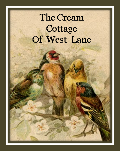Growing Basil at Home
I am a true fan of Basil. My favorite is the 'Sweet Basil' variety . Last year a friend from "WW" gave me a recipe for Pesto (which you can find on my "Let's Get Cook'n" page above), from that point on....I was hooked. The only problem with this new found love was, in order to purchase enough basil for this recipe from my local supermarket was outrageously expensive!
The only way around that I thought was to grow it myself.
And that I did...
Below are the guidlines I followed of "Growing Basil at Home"
Basil, Ocimum basilicum, is a member of the mint family. It is aromatic, much like mint or tea, and both the leaves and stems can be used in recipes in fresh or dried form.
This annual grows from one to two feet tall and produces flowers in white, shades of pink and even purple during late July and into August in the Northern Hemisphere.
A common ingredient in Italian recipes, it is an herb used worldwide. It has long been used as an ornamental, incorporated into herbal remedies, used to create flavored vinegars, teas, and a key seasoning in many recipes.
Basil Throughout History
“Basil” as a name is believed to come from the Greek word “basilikon” which means “king” or “royal”, hence the nickname “king of the herbs”. It is also possible that it comes from the Latin “basiliscus” which refers to a mythical dragon capable of breathing fire. In Roman legend, it is considered an antidote to the venom of the dragon. The botanical name, Ocimum, comes from the Greek word which means “to be fragrant”.
Asian foods have benefitted from basil since ancient times. Hindus in India once thought being buried with a basil leaf would act as a passport to heaven. Basil was considered sacred also to India’s gods Krishna and Vishnu.
By the 1600s, the English included basil in food and around doorways to ward off evil spirits and discourage pests such as flies. Young Englishmen wore it as a courting sign that they had serious intentions with their girlfriend. By the 1800s, both Europeans and Americans learned of the mild sedation experienced when basil was added to bathwater, in massage oil, or taken as tea.
Starting from Seed Tips !
http://growingbasilblog.com/6-tips-for-growing-basil-from-seed/
Using Basil
Basil has value for its beauty as well as flavor. Fresh or dry leaves can be added to stews, soups, sauces, as well as meat, fish or egg dishes. It seasons salads and vegetables and flavors teas and vinegars or steeped into flavored oil.
Salads and flavored vinegars are best with purple basil. It is also the best choice for annual gardens and flower displays.
Scented basils, like cinnamon or lemon, add a special touch to dishes with delicate flavor. It is use for jellies, jams, and even sorbets.
Tomato dishes benefit from basil adding to the flavor or pizza, spaghetti sauce, soup, dressings, salads, sausage, virtually anything tomato-based. When blended with pine nuts, oil and cheese in appropriate amounts, it create pesto. Many Italian chefs prefer it to oregano. Often considered mainly for main courses, it can add flavor to fruit desserts.
Cultivation of Basil
Basil grows indoors wonderfully when placed in a sunny window but plants grown in outdoor gardens develop more distinctive flavors and fragrances. It really wants full sun. As foliage is removed to use as spice, basil enjoys a weak application of complete-balanced garden fertilizer, 5-10-5 being perfect, early in the growing season. Don’t over fertilize or the flavor and fragrance will suffer.
Start your basil garden by buying plants from a garden center. You can also start seeds indoors or sown directly into the garden outdoors.
If you sow seeds outdoors, avoid planting before night temperatures remain always above 50 degrees F. Sow basil in a shallow furrow, about ¼-inch deep. Once germination occurs, thin sprouts to 1 foot between plants and space rows two-feet apart. Maturity is reached between 70 and 80 days.
If you start basil inside for outdoor transplant, sow seeds about six weeks be the final frost in your locale. Cover seeds with soil, just to ¼-inch and keep them in 70 degree F temperatures or more. They like moisture and low moisture or exposure to temperatures that are too chilly will cause basil to suffer. Once the first true leaves appear and frost has passed, transplant your basil by lifting the plants carefully by the leaves rather than the stem.
Every variety of basil is sensitive to frost but hot weather causes growth to thrive. An early chill in the growing season will cause the plants to never grow well and purple basil is the most susceptible to stress in early growth.
Harvesting Basil
Obtain the best flavor by harvesting when flower buds just begin to form but have not begun to open. Let the plants bloom fully if for use in vinegars. Pinkish-white to purple shades incorporate color into vinegars.
Harvest basil on a dry day, gathering in the morning just after the dew dries but before the heat sets in.
Preserving Basil
Dry basil on a rack or flat on a tray rather than tied in bunches for hanging. Cover the rack or tray with cheesecloth to keep dust or pests off and place in a warm, ventilated area away from direct sunlight for one full day.
Collecting,Creating,and Painting it Cream !
Welcome to West Lane
This blog is all about my love (or as I call it "addiction") of
collecting, decorating, cooking, quilting, & fun DIY projects.
collecting, decorating, cooking, quilting, & fun DIY projects.
About Me

- Judi
- Kentucky, United States
- Hi, I'm Judi (with an "i") as my friends say. I'm married to a wonderful husband of 33 years, and blessed with being a mother of 2 grown children, a son & a daughter. I live in the beautiful Bluegrass State (KY) and blog about my passion for creating, cooking, decorating, collecting, and life!
Follow Me
My Button

Blog Archive



~~~~~~~~~~~~~~~~~~~~~~~~~







